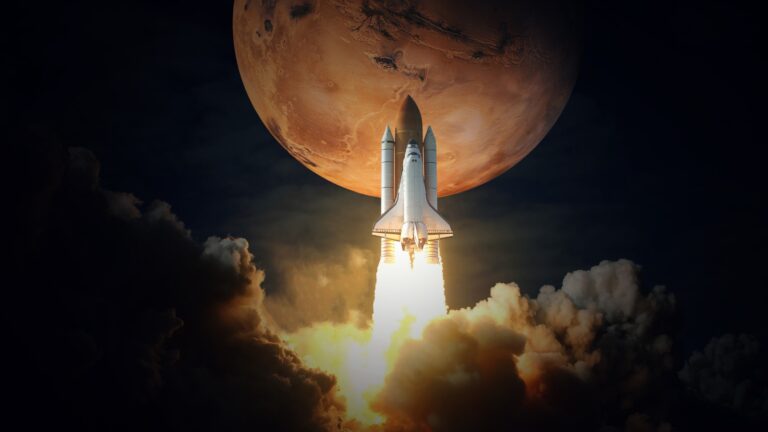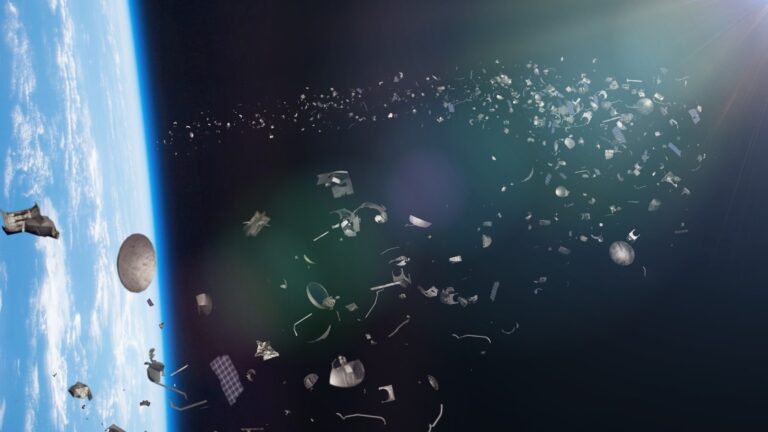Satellite technologies are vital in ensuring global connectivity and safety, making them the guardian machines in space that keep our world intact. However, what if there is a threat to these satellites and, by extension, Earth itself?
Space debris is an exponentially growing problem as defunct human-made junk remains in orbit around Earth after being disposed of. A collision between pieces of debris or with operational satellites could be devastating, terminating entire missions or generating enormous new debris fields. About 1 million pieces of debris are 1 centimetre or larger and move at multiple times the speed of sound.
The risk of collision between satellites and debris is a serious concern, and it will only get worse as more satellites are launched into orbit. It is essential to mitigate this risk by developing better tracking systems for debris and developing technologies to remove debris from orbit. This article imparts knowledge about space debris, missions already focusing on mitigating the risk of space garbage, and their challenges.
Space Debris: Then and Now

Space debris comes in various sizes, from tiny bits to old spacecraft. Due to their fast orbital speeds, millions of smaller fragments threaten operating space systems. Here is a summarised timeline that shares milestone information about Space Debris.
1957: Where it began
The launch of Sputnik I in 1957, which signalled the beginning of orbital junk, is the origin of space trash. The United States Air Force launched Project Space Track as a result of this incident, with the intention of monitoring spacecraft. Space-related activities increased dramatically in the 1960s, including anti-satellite tests and spacecraft explosions, which added to the buildup of space debris.
1978: Kessler Syndrome- Hinting a Debris Problem in Future
Scientists Don Kessler and Burton Cour-Palais predicted the Kessler Syndrome (explained in detail below) in 1978, which postulated that collisions rather than new launches would cause debris buildup. The problem of space debris has received a lot of attention since this forecast. Numerous projects and programs were started to identify and manage space debris in the late 1970s and 1980s.
2001: IADC was Established
The Inter-Agency Space Debris Coordination Committee (IADC) was established in the 1990s, and technologies for studying space debris were also developed at this time. The Orbital Debris Mitigation Standard Practices, published by the American government in 2001, include recommendations for debris mitigation.
2005: Space Fence Radar System Initiated
Recent innovations include the operational Space Fence radar system and tools for tracking uncorrelated tracks. Large “NewSpace” constellations have multiplied, changing the ratio of functioning spacecraft to junk in low Earth orbit (LEO), emphasising the need for space traffic management.
2007: Chinese ASAT Test
Breakups, particularly those brought on by anti-satellite tests, have historically been a significant source of space debris. Significant occurrences like the Chinese ASAT test in 2007 and the collision of the Iridium 33 and Cosmos 2251 satellites in 2009 sparked increased efforts to avoid collisions and remove debris.
What Is Kessler Syndrome or Collisional Cascading?
The Kessler Syndrome is a galactic happening where space debris collides with each other, and at a point in time, it multiplies into more space debris as a causal effect of collision. NASA explains it as “a dangerous phenomenon because it renders orbits less accessible for all states to reap the scientific, technological, and economic benefits. ”
Galactic Mission That Proved the Repercussions of the Kessler Syndrome
A risk to space activities was generated by Russia’s recent anti-satellite missile test, which destroyed a retired Soviet spacecraft and left behind a field of debris with some 1,500 trackable pieces. Every 90 minutes for several hours, the International Space Station had to take precautions as it flew through or close to this debris field. According to France, this incident elevated the probability of a Kessler Syndrome occurrence by 5%.
Low Earth Orbit (LEO) orbital debris moves far more quickly than commercial aircraft, and even little bits larger than 1 cm can seriously harm or even destroy satellites. NASA, NATO, as well as governments from countries like Australia, the United Kingdom, Japan, France, and the United States, denounced Russia’s missile launch as dangerous.
Space Policies That Can Hinder Debris Collection

Expert criticism underscores a glaring issue in the realm of space exploration: the outdated and insufficient state of space policies and regulations. They highlight a startling fact – the fundamental legislation governing space activities has remained virtually unchanged since 1966, a time when only two nations were actively involved in spacefaring endeavours. In stark contrast, today, we witness the involvement of approximately 84 countries and organisations, each with its own satellites and space technology projects. This glaring disparity between policy stagnation and the rapid evolution of the space sector has emerged as a pivotal challenge.
Particularly concerning is the lack of a robust regulatory framework to address the menace of space debris, which puts the future of space activities, encompassing human missions, satellite operations, and even space mining, at considerable risk. Consequently, a growing consensus among major spacefaring nations is driving concerted efforts towards developing comprehensive and up-to-date space policies that can effectively navigate the multifaceted challenges posed by space debris and other dynamic facets of modern space exploration.
The Legal Issues
- There are no specific guidelines for dealing with space debris under the 1967 Outer Space Treaty.
- According to the Liability Convention of 1972, launching states are accountable for the harm caused by debris; there are tighter restrictions for damage in outer space.
- Establishing fault, locating responsible states, and demonstrating harm are all necessary steps in filing claims for debris damage.
- International guidelines for debris reduction are not enforceable, which makes determining who is responsible more difficult.
- Legal issues of ownership, surveillance, and technological disclosure surround active debris removal.
- For active debris removal, precise contracts and liability arrangements are required.
- Despite potential cost increases, international cooperation is essential to eliminate space debris and prevent the Kessler Effect.
- Article VIII of the Outer Space Treaty provides that each State retains ownership and control over objects launched into space- so how are the galactic garbage collectors going to collect something owned by other countries?
Space Sweeping- Is Someone Successful in This?

Cooperation between national and international parties is essential to preserve the long-term viability of space. Companies like Astroscale are actively involved in creating technology and solutions for debris removal, as are initiatives like RemoveDEBRIS.
These businesses specialise in technologies for in-orbit maintenance, such as spacecraft that can dock and rendezvous with other spacecraft. These satellites can keep operating longer or securely deorbit obsolete junk clogging low Earth orbit. Although it had thruster troubles, Astroscale’s End-of-Life Services by Astroscale (ELSA-d) demonstration system is still moving forward and successfully demonstrated the magnetic capture and release of a spacecraft. In partnership with the Japan Aerospace Exploration Agency, the business is preparing Active Debris Removal by Astroscale-Japan (ADRAS-J), another debris-removal demonstration project.
Mitigate Space Catastrophes for the Future

It is crucial to deal with this issue to protect priceless satellite systems and maintain the feasibility of space exploration and use. While there have been ongoing efforts to reduce space debris, the developing space industry and old legal frameworks highlight the need for global cooperation and modernised rules. By creating cutting-edge technology for debris removal, initiatives like RemoveDEBRIS encourage and emphasise the significance of coordinated international efforts to safeguard and maintain the space environment for future generations.
Finally, the threat posed by space debris necessitates immediate attention and action. Comprehensive methods are needed, including legal changes, responsibility agreements, and internationally enforced standards, to protect our capacity to explore and use space. We must acknowledge that, as we confront the problems caused by space debris, the “guardian machines” in orbit serve an essential function in preserving the long-term viability of the space environment. Our collective resolve to approach this complicated challenge with inventiveness, cooperation, and a sense of responsibility for the future of humanity’s activities beyond Earth will determine the course of space exploration. Stay tuned to Cerexio blog articles to learn about the latest space and technology news.

